How to Twitter
Lee Phillips
July 12th, 2020
Believe it or not, Twitter can be a very useful source of information and news. Or, it can waste your time and make you sad. It’s all in how you use it. Here I’ll show you how to make Twitter work for you, instead of against you.
There are many things you can do to turn Twitter into a useful tool, but there is one central concept that is more important than everything else combined. If you absorb and apply this idea, you will transform Twitter from a source of pointless irritation into a veritable lifehack.
The secret is to completely separate the concepts of following and reading.
Let me explain: the person finally giving in and signing up for Twitter looks for instruction and advice on how to get started and how to use it. This advice, either from helpful writers on the internet or from Twitter itself, goes something like this:
Look for people who are interesting to you;
Follow them;
Observe your timeline, where their tweets will appear.
If you follow this advice, you will be doing it wrong. This is the exact opposite of how you should use Twitter. The problems with this approach are:
You may see the tweets not always in the order in which they were tweeted, but in some other order that Twitter creates for you;
You will see “promoted tweets” interpolated between the tweets you signed up to see. This is paid advertising;
You will see random other things you didn’t ask for;
You will be inundated with “suggestions” from Twitter about people to follow, trending topics to keep on top of, and other irrelevant nonsense;
You will never see some of the tweets tweeted by the people you are following. They simply will not appear in your timeline;
Everyone can see the list of people you follow. You may or may not want this;
You will discover that the people you followed because you admire them have nothing interesting to say, only tweeting cat pictures and worn-out memes.
In short, you will be fed tons of stuff you never signed up for, and not get what you wanted.
You can’t turn any of this off. Twitter lets you tell it that you want to see less of some kinds of things, but there are no actual settings to turn off advertising or suggestions about fascinating hashtags.
The first step in fixing Twitter for yourself is to understand what following is really for. You don’t follow an account because you want to read their tweets. Twitter is “social media”, and following is a social signal. When you follow someone you are declaring that you approve of that person. Whether or not this is what you intended, this is how your decision to follow someone will be interpreted. If you are, for example, a journalist researching neo-Nazis, and part of your research involves tracking what they are saying on Twitter, you may not want to be seen as endorsing these people.
Obviously, you may want to read certain people’s tweets without following them. And you can! Twitter allows you to create private lists of accounts that you can track without following. You can see all their tweets scroll by without appearing to have endorsed them. The composition of your private lists, and even their existence, will remain secret. The people you add won’t know you’re adding them, nor that you’re seeing their tweets, unless you choose to interact with them. In addition, the tweets will appear in chronological order, with no interpolated advertising nor any other junk, unlike in your timeline. But you must not forget to mark the lists as private. In the picture below, one arrow points to the widget for creating a new list, and another points to the all-important checkbox for making the list private. You should only make private lists; there is no reason to make public lists, and, in fact, some people object to being placed in them (for some reason that escapes me, but behavior on Twitter is weird in many ways).

Make as many lists as you want, as fine-grained or as general as you think will be useful to you. You can have an astronomy list, or a list just with people who talk about astrophotography with iPhones. You can make a list for local news, and one for international news. You can put accounts in more than one list, so the exact composition of a list is not a crucial decision. This is how you separate the concepts of reading and following. You follow when you want to let people know you are following (hi, Mom), and you want everyone else to know, too. When you become famous and have a million followers, you can follow others to amplify their signals. Until then, follow to encourage, to lend support, and to let others know where you stand. If you also want to read the tweets of someone you follow (and you might not), put that person in one of your lists in addition. Your followee’s tweets will also appear in your timeline, but you won’t see them there, because you will never look at your timeline. Of course, you literally don’t have to follow a single person. Following is public. Aggregating accounts into lists is your private business.
Lists become most useful when there is an interface for conveniently seeing what’s on them. The regular Twitter clients are not very good for this, but Twitter has an alternative client that is made for it. Use TweetDeck. It divides your twitterverse into columns. Each column can contain the tweets from one of your lists; in addition, you can create columns that track search terms, individual accounts, hashtags, your notifications, your direct messages, and more. By default, it will have a column with your timeline, but you can delete that, because, as I hope is clear by now, your timeline is a waste of time.

This interface, although not perfect, helps a great deal in making Twitter more useful. If you keep it open, it can be a low-distraction way of monitoring recent tweets from low-traffic lists. You can delete columns you don’t care about today, and add them back in tomorrow.
Lists and search terms, combined with the avoidance of the timeline and the use of TweetDeck, already turns Twitter from a cesspool with advertising into a useful news feed. But by combining this with a few other practices, you can make Twitter even better.
First, control yourself. Use the platform as a source of timely information, and as a way to be helpful with others by offering information or advice. Do not, ever, no matter how strongly you feel that someone is wrong, get into an argument on Twitter. I have often failed to heed this advice myself; do what I say, not what I do. Twitter can be a fantastic source of news from all over the world; it is often the first place you will hear about something, and sometimes the only place. It can be a very useful platform for receiving and offering technical information, such as links to papers. I recently contributed a scrap of code, in a tweet, for a maintainer of the venerable linux utility curl; the result is in this commit. This kind of interaction is satisfying, but trying to have an actual discussion or argument never is, because it is impossible to do with this platform. At best, you will score points against someone not as clever as you; and that and $2.50 will get you a cup of coffee.
Next, use the muting function. Even members of your carefully curated lists will sometimes decide to spend a week talking incessantly about their new sneakers. Mute them until they get over it. Mute words and phrases, too, for those times when a bunch of people are talking about something that you don’t care to see in your feeds (NBA playoffs, political debates, you name it).
When you discover someone interesting on Twitter, check their profile for a link to a website.  Click on it. If the person is worth following on Twitter, his or her website is likely to be of even more interest. Check the site for an Atom or RSS feed (look over to the right to see where I’ve used a version of the Atom/RSS feed icon). If there is one, subscribe in your feedreader. If you don’t have a feedreader, you should set one up. I use Newsblur.
Click on it. If the person is worth following on Twitter, his or her website is likely to be of even more interest. Check the site for an Atom or RSS feed (look over to the right to see where I’ve used a version of the Atom/RSS feed icon). If there is one, subscribe in your feedreader. If you don’t have a feedreader, you should set one up. I use Newsblur.
I hope I’ve shown you some ways to make Twitter work for you. If you have any additional suggestions, please leave me a comment so I can incorporate them.
lee-phillips.org is a participant in the Amazon Services LLC Associates Program, an affiliate advertising program designed to provide a means for sites to earn advertising fees by advertising and linking to amazon.com.
from Hacker News https://ift.tt/307xuBy
No comments:
Post a Comment
Note: Only a member of this blog may post a comment.